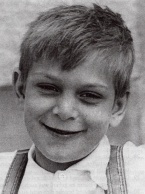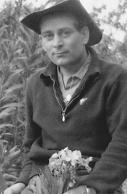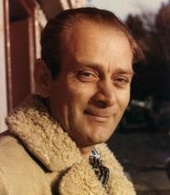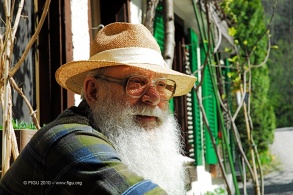Introduction
The entire website is about Eduard Albert Meier. More information is available... [continue reading]
The short biography page offers a brief text about the course of the life of 'Billy' Eduard Albert Meier. Brief biographical extracts can also be found below.
- Biography is an account of someone's life written by someone else. Lengthier biographies are available on the Downloads page under ebooks and 'relevant books by other authors' section.
- Autobiography is an account of a person's life written by that person. Several of Billy's books are autobiographical but most have not been translated from German, see shop.figu.org.
- Interviews are face to face recorded discussion. They are typically informal in a casual setting with Billy, both because we and he himself prefers it that way and its more comfortable. The Interviews with Billy page has some. However Billy has given more formal interviews for television and media in the past, see downloads, ebooks, 'relevant newspaper and magazine articles by other authors' section for a limited selection and other are available on Youtube.
- Memoirs is a historical account or autobiography written from personal knowledge. See Books section and shop.figu.org. Less of these texts have been translated into English because Eduard's written works about humanity have been deemed a higher translation priority divvied among the limited number of translators that exist. If you can read German, enjoy a much richer account of Billy's interesting life.
Who is Billy Meier?
'Billy' Eduard Albert Meier (BEAM) was born in Bülach, Switzerland on the 3rd of February, 1937 and currently resides at the Semjase-Silver-Star-Center (SSSC), Hinterschmidrüti, Switzerland, which he helped build and establish. For over 80 years he has been regularly communicating face to face and telepathically with extraterrestrial human beings and has published that information. As one might envisage, over such a brilliant quantity of time, they've managed to explain everything in full. An extraordinary quality of interesting facts, opinions and perspectives we've never known before, and still don't honestly, how could we in reality (and that's part of why they are doing it). All of which has been inciting enough to initiate many thousands from around the world to read into everything. He has had a life rich with all different kinds of experiences in many countries, many of which were extremely difficult, nonetheless important and useful for his evolution and mission in life. [continue reading]
He began contacts with the Plejaren in 1942 at the age of 5 years old. These contacts have been ongoing ever since and have also expanded to contacts with other extraterrestrial beings throughout the universe. The wider Plejaren Federations homes are located on many different worlds and the Plejaren themselves have three home-worlds in a time-shifted dimension Plejares (well beyond the seven sisters) star system. Initially they called themselves Pleiadians and later Plejaren in order to ensnare the early fantasist fiction-rich reality-estranged writers who intercepted the Plejaren's explanations prematurely. Far before the ripe time to properly unfold what had been given, to root it in reality and determine exactly what it was they were trying to explain had reached its time. The arrangement has created a natural stratific order, allowing readers to independently establish clarity. For what would become as a story confusing enough to follow, involving the entire world and all of its history. Without that fantasy-rich glazing which unfortunately originated from shallow, ephemeral journalists taking out of context the most sensationalist revelations to humiliate him without even appreciating the original explanation.
Billy, acting as teacher, mediator and spokesperson, unravels the fascinating, often previously mysterious, things they've been granted permission to explain for us; in order to assist us all in the wider good of our monumental task, moving forward into the future, of guiding ourselves, our planet Earth, and our own mankind, slowly toward actual civilization.
The most important information imparted by Eduard and his contacts is the knowledge of the true spiritual teaching, together with the contact information with reference to many topics concerning terrestrial humankind.
Billy's communication with extraterrestrials has as one might expect been controversial, but the more we read about it the more we begin to appreciate why it's needed to be. It began for Eduard at age five where he was prepared for a life's work by Sfath, an elderly extraterrestrial man from Erra. Asket, his second teacher, continued the education for a further eleven years. Where then later Billy travelled the world, with Asket guiding him, through the worlds many lands and territories, in such a way that he could learn first hand about all the different beliefs and cultures, so that later he knew how to reach them as a writer.
On the 28th January, 1975, he began the series known as the
Contact Reports with
Semjase, a Pleiadian/Plejaran woman. The articles and excerpts contained here expound upon his very extensive and interesting life. It was at this time that the opportunity was presented to Billy to photograph several of their
Beamships/anti-gravity spaceship manoeuvres as a means of giving weight and fortifying the position, story and claims. He took plenty of photos, over 1,000, some of these are presented in the
Gallery. The
contact conversations were stored by the Plejaren on a device and resent to him telepathically so that he could type them out later. They contain many interesting things about history, humanities, sciences and spiritual topics. Since 1989 Billy has been having approximately four meetings a year with
Ptaah, the father of Semjase, and there is now well over 700 contacts to read. The Plejarens life expectancy is roughly ten times ours, so a certain maturity and fundamentally different perspective is quite often presented in these documents.
ca.figu.org/billy-s-contacts (external)
Introduction to Billy in English by FIGU Canada.
au.figu.org/beam (external)
Introduction to Billy in English by FIGU Australia.
theyflyblog.com/about-billy (external)
Introduction to Billy in English by Michael Horn in U.S.
Eduard Meier's general life timeline
Please note: source hasn't been verified for some entries, requires veracity and citation from original books.
1937 – Billy Meier is born in Bülach, Switzerland on the 3rd of February.
[continue reading]
1942 – Age 5 – Has telepathic communication with extraterrestrials.
1951 – Age 14 – Billy Meier is arrested and convicted of assault[citations needed] and sent to youth[citations needed] prison.[1]
1951 – Age 14 – Sends a letter to 3,000 heads of state around the world which contains information concerning his conversations with extraterrestrials.
1953 – Age 16 – Arrested a second time,[citations needed] convicted,[citations needed] and sent to youth prison.[citations needed]
1953 – Age 16 – Escapes from prison[citations needed] and joins the French Foreign Legion.[citations needed]
1955 – Age 18 – Walks away from the French Foreign Legion with a French goodbye[2] and returns to Switzerland to face further prosecution.[citations needed] Institutionalized for a further two years.[citations needed]
1958 – Age 21 – Posts a letter entitled “Warning to all the governments of Europe!” to all governments of Europe as a warning about their behaviour.[citations needed]
1960 – Age 23 – Travels to the transcontinental region centred around Western Asia, Turkey, and Egypt, i.e the Middle East[citations needed] to work as an unskilled labourer paid by the day,[citations needed] with no promise that more work would be available in the future.[citations needed]
1963 – Age 26 – With Isa Rashid[citations needed] engages amateur archaeology[citations needed] and urban exploring[citations needed] but never parkour[citations needed] under the telepathic guidance[citations needed] of extraterrestrials who lead him to discover several things, one of which things later is explained to be the tomb[citations needed] of Jmmanuel (commonly known as Jesus Christ with some date and text attribution discrepancies lead by the Vatican money laundering business over several centuries).[citations needed]
1964 – Age 27 – Takes the first known photos attributed to him[citations needed] of UFO's while in India (see Photo Gallery).
1964 – Age 27 – Expelled[citations needed] from India on charges of vagrancy;[citations needed] specifically the charge of outstaying one's travel visa.[citations needed]
1965 – Age 28 – Has his left arm partially amputated after a hideous accident,[citations needed] where he was hanging it outside the window of a bus as it crashed.[citations needed]
1967 – Age 30 – Meets and later marries Kalliope.[citations needed]
1975 – Age 38 – Billy Meier founds the non-profit organisation FIGU.[citations needed] In a similar vein as Edgar Cayce founded A.R.E. for the public good and for like-minded community for individuals engaged in the study of the information.
1976 – Age 39 – Billy Meier’s UFO photos are published for the first time in an Italian magazine.[citations needed]
1979 – Age 42 – Billy Meier sends President Carter a letter encouraging a meeting with the Plejaren.[citations needed]
1979 – Age 42 – Genesis III’s[citations needed] “UFO…Contact From The Pleiades: Volume I” is published.[citations needed]
1981 – Age 44 – Wendelle Stevens's “UFO: Contact From The Pleiades: A Preliminary Investigation Report” is published.[citations needed]
1982 – Age 45 – Genesis III’s “Contact From Pleiades” documentary movie is released.[citations needed]
1983 – Age 46 – Genesis III’s “UFO…Contact From The Pleiades: Volume II” is published.[citations needed]
1985 – Age 48 – Intercep’s “Beamship: The Movie Footage” documentary movie is released.[citations needed]
1988 – Age 51 – Wendelle Stevens’ “Message From The Pleiades: The Contact Notes of Eduard Billy Meier” is published.[citations needed]
1989 – Age 52 – Wendelle Stevens’ “UFO...Contact from the Pleiades: A Supplementary Investigation Report” is published.[citations needed]
1990 – Age 53 – Wendelle Stevens’ “Message From The Pleiades: The Contact Notes of Eduard Billy Meier (Volume 2)” is published.[citations needed]
1990 – Age 53 – Billy Meier’s “The Talmud of Jmmanuel” is published.[citations needed]
1991 – Age 54 – Guido Moosbrugger’s “…und sie fliegen doch!” (“…and yet they fly!” German version) is published.[citations needed]
1993 – Age 56 – Wendelle Stevens’ “Message From The Pleiades: The Contact Notes of Eduard Billy Meier (Volume 3)” is published.[citations needed]
1995 – Age 58 – Kal Korff’s “Spaceships of the Pleiades”, a critical examination of the case, is published.[citations needed]
1995 – Age 58 – Wendelle Stevens’ “Message From The Pleiades: The Contact Notes of Eduard Billy Meier (Volume 4)” is published.[citations needed]
1997 – Age 60 – Kalliope divorces[citations needed] Billy Meier and says that Meier’s contacts are “entirely fictitious”.[citations needed]
1999 – Age 62 – “The World’s Greatest Hoaxes: Secrets Finally Revealed” is broadcast.[citations needed]
2001 – Age 64 – Guido Moosbrugger’s “And yet…they fly!” (English version) is published.[citations needed]
2004 – Age 67 – Guido Moosbrugger’s “And still they fly!” is published.[citations needed]
2007 – Age 70 – Billy Meier’s “Talmud Jmmanuel” is published a second time.[citations needed]
2007 – Age 70 – Michael Horn’s “The Silent Revolution Of Truth” documentary movie is released.[citations needed]
Light Years by Gary Kinder - One A
A description of Eduard Meier found in a book called Light Years written by Gary Kinder which is all about him and his life; in section One A.
"History first mentions the village of Hinwil, Switzerland in a document dated 745. Thirty
miles southeast of Zurich, it nestles in a landscape of rolling green hills pocketed by large
islands of forest a hundred feet tall, with the Alps rising in the distance. Hinwil itself, perhaps, would disappoint the tourist looking for the charm of alpine architecture: though chalk-white chalets shuttered in green rise from the village core and scatter among the hills, many stark buildings constructed of concrete have risen in their midst. They resemble not so much the quaint cottages in travel brochures as they do utilitarian apartment buildings erected in the 1950s and '60s in the United States.
But a short distance from the village center, along the street Wihaldenstrasse, stands a three-story farmhouse built a hundred years ago. During the mid-1970s, summer grape vines
climbed the sunny south wall of the old house. Flowers filled a stone water trough to the north near the entrance, and small birds fluttered in an aviary built of wood and wire. To the south and east of the house lay a small green field, and to the north and west stood more of the cold, institutional apartment buildings.
The community of Hinwil had acquired the old farm years before and built the surrounding
apartments to house senior citizens. Though the farmhouse someday soon would be torn down
to make room for more apartments, the community now rented the house for a nominal sum to
an unemployed night watchman, Eduard Meier. Meier lived in the house with his Greek wife,
Kaliope, nicknamed Popi, and three small children-a girl, Nina, a boy, Atlantis, and the baby, Bashenko. They had been living in the house since December 1973 though they had lived
elsewhere in Hinwil for two years.
Meier, a man of thirty-seven, had a sixth-grade education. He was not a very big man, maybe
five feet, seven inches tall, but he was thick-chested and strong. His face was handsome, set
off by unusual greenish-hazel eyes. According to village records, Meier's professions were
"bird breeder, iron layer, night watchman." He held a permit to carry a gun because he had
once worked as night security in a factory. [continue reading]
In a former house, a tiny three-room row house contiguous to the Hinwil village museum,
Meier had kept a cage out back filled with nearly two hundred birds. He had been employed
then as a night guard and, consequently, was often at home during the day. But many people
in the neighbourhood avoided talking to Meier because he was "different." He spoke a great
deal about Moses and said things other people did not understand. Julios and Erika Kagi knew
the Meiers better than other neighbours did because they had a daughter the same age as Nina
and the two girls often played together. "He had a terrific fantasy," remembered Erika Kagi,
"and I could not agree with his philosophy. But he was not a bad person. He was not even
odd; he just had his own ideas and believed whatever he said." Said another neighbor, "Meier
lives the way he wants to and does not adapt to anyone else's way of living."
Meier had only one arm. His left arm had been severed just above the elbow in a bus accident
in 1965, as he traveled from India, through Turkey, and back to Switzerland. Still, when part
of the barn adjacent to the small house collapsed, Julios Kagi saw Meier rebuild the wall
alone by holding the boards in place with his shoulder stump while he positioned and pounded
nails with his one hand. "He was faster with one hand than other people are with two,"
recalled Kagi.
Again out of a job, Meier now supported his family on the 700 francs provided him every
month by the government for the loss of his arm. To supplement their income, the Meiers kept
chickens in the attic of the old farmhouse, and Popi sold eggs to the neighbors.
To neighbors living in the apartment buildings overlooking the front door of the farmhouse,
Meier seemed to be always home. In a culture that values hard work and conformity, the
neighbors saw him as a singular and idle man, often lost in thought, as though the weight of
the world rested upon his shoulders, and they began to talk.
Then, on the afternoon of 28 January, 1975, a cold day but warmer than most at that time of
the year, Eduard Meier left the farmhouse on his moped, towing a tiny wagon behind him. He
wound through the streets of Hinwil, steering with one hand, the empty left sleeve of his
leather jacket jerking in the wind. Working his way out of town, he eventually came to a
country road, which he followed for a time, then disappeared into the forest of a nature
conservancy. A few hours later, he returned to the farmhouse without telling anyone where he
had been.
Several days passed, during which the neighbours saw Meier dawdling around the house,
seemingly as always without purpose. Then, one afternoon, he again pulled his moped from a
storage room, pedalled it down the driveway until the tiny motor kicked over, and rode
through the village out into the country. Soon, he was lost from view in another of the islands of forest surrounding Hinwil. When he returned, as before, he told no one where he had been or why he had been there. But the Swiss are observant and curious people, and the neighbours noted his peculiar comings and goings.
Within weeks, Meier was travelling regularly into the forest, guiding his moped with one hand, the tiny wagon behind. Each trip seemed to take him along a new path in a new direction
through town and out into the country highways, often for as long as an hour. Later, many of
his trips took him into the hills. Sometimes, he would disappear in the early afternoon and not be seen again before supper; other times, he would sneak from the house at one or two in the morning and not return till dawn.
"He had to go away again and again," Popi remembered. "He would come home for five
minutes, fix himself a cup of coffee, and hop, he was gone again. It was bad at night. You'd be sleeping peacefully and the kids were quiet in bed. All of a sudden, he would get up, get
dressed, and be gone. You know? You think your husband is lying in bed next to you, but he
is gone. I did not know anything. All he said was that he was going to work."
As the weeks passed, Meier's journeys through town and into the forests began to occur three,
four, even five times a week. And his frequent departures rubbed against the grain of order
and routine so conscientiously observed by his neighbours. The more he disappeared, the more
they talked.
"The people in the neighbourhood didn't know any thing about what was going on," said Popi,
"but they were very curious. They could tell me, to the minute, when he left on his moped and
when he came back. It was always the same questions. 'Why did he come home so late?'
Sometimes he got up in the middle of the night and left, so they would hear the moped. And
when he did this, it was even worse with the people the next day. 'Why did he leave last
night?' 'Where did he go?' I would say nothing. I wasn't interested. They are just
Schnuriwiiber [gossips]."
On clear nights, neighbours living in the apartment building just above the farmhouse saw
Meier standing in the alleyway to the west and watching the sky through binoculars for hours.
On nights when he did not leave the house, neighbours to the east saw a light burning on the
second floor late into the night.
A week, a month, maybe two months passed, Popi could not remember. Then, one afternoon,
as the two of them stood in the small living room on the second floor of the house, her
husband handed her photographs.
"What do you think of this?" he asked.
But Popi only stared at the pictures.
"I was shocked," she recalled, "because I saw something completely new, and I did not want
to believe that this existed. He said nothing at all. Didn't explain. Not one word." Her husband merely picked up the pictures and left the room, as Popi yelled at him for wasting his time taking pictures when money for the family was so scarce.
Meier next took the photographs to his friend Jakobus Bertschinger, whom he had met while
working at the Piatti gravel pit years earlier. Though Jakobus was twelve years younger than
Meier, the two men had struck up a lasting friendship. They spent much time together, talking
about Meier's experiences during the twelve years he had travelled back and forth through
India and the Middle East. But Jakobus, too, seemed confused by the photographs Meier
showed to him. He even laughed, but he promised to help his friend in any way he could.
With a loan from Jakobus, Meier placed a small classified ad in the German publication
Esotera. The ad solicited people interested in forming a group to discuss natural life, logic, and truth-things "metaphysical."
Several more months passed. Through the summer and fall of 1975, the neighbours along
Wihaldenstrasse watched Meier continue his frequent trips into the foothills and forests at all times of the day and night. On his little green moped, he often was seen at the edge of the open road, putt-putting along, twenty, maybe twenty-five miles an hour, passed constantly by the much larger and faster automobiles. But then, something new entered Meier's routine: one Saturday afternoon, a half-dozen cars appeared at the farmhouse and remained till late at
night.
The neighbours did not understand why people came to see this man. He was poor and
handicapped, with an unkempt wife who spoke little of their language. He did not work, and
his habits seemed strange. But over the weeks and months, not only did the visitors continue
to come, but their numbers increased. In the tiny parlor on the second story, the man with the single arm and unusual hazel eyes spoke to these people for hours. When they left, the
neighbours heard Popi screaming at him. For many months, the neighbours watched Meier disappear frequently at odd hours and saw the
cars on Saturday afternoons filling the narrow alleyway, running alongside No. 10
Wihaldenstrasse, and spilling onto the streets of Hinwil."
Source: Light Years Gary Kinder PDF (external)
Common misconceptions
List of common misconceptions about the FIGU information by subject
Explanation about the broad subject of why
[show/hide]
- Billy must take the precaution to not allow the knowledge of how and at what point in time he will depart from all others unexpectedly and unassumingly from the worldly living area, so that an idol would not be made of him, if the dates would come to be known. Its only allowed to be known that he will again, in around 800 years, be the centre point of this innermost group, as this already existed in earlier times on various occasions and also exists today.[3]
- He does keep in touch with his biological brothers and sisters, with two (Hedi and Berti) of his three sisters who are still alive. His two brothers and one sister (Vreni) are dead.[4]
- Billy is neither the author nor responsible for a significant part of the information, much of it is Plejaren Federation. Billy alone with respect to him, does not have the intellectual capacity alone to reveal some of the particulars of mysteries and widest conspiracies that he has, its required a moderate medium to large team consisting of thousands of individuals, many technologies and a computer with a history and future database on it among several other particulars we cannot credit him alone for fathoming how to do.
That constitutes the more fundamental reason why those that have actually read the content tend to lean toward it being absolutely authentic and appreciate it. While those that read a sensationalist stupid summary from a newspaper, comment on social media or petty discovery channel documentary segment tend to lean toward it being like any and all the other shod available for ufo entertainment purposes. Unfortunately the time it takes to read and examine it takes far too long for most readers.
- Despite everything the bravest thing Billy has ever done has admitted an incredibly personal relationship with Islam.
Q&A
Q: Why do Plejaren visit Billy on his birthday consistently if they don’t celebrate annual celebrations?
A: When on Earth they do as the Earth folks do,[citation needed] aside that it establishes a seasonal rhythm, and Billy has a special date and time according to explanations given by The High Council / Arahat Athersata.[citation needed] So they tend to bring new seams of knowledge to Billy on his birthday, thus why his birthday Contact Reports are found to interest most readers.
References




